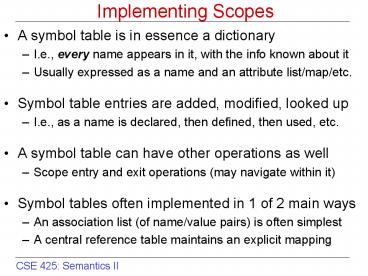Implementing Scopes - PowerPoint PPT Presentation
Title:
Implementing Scopes
Description:
Implementing Scopes A symbol table is in essence a dictionary I.e., every name appears in it, with the info known about it Usually expressed as a name and an ... – PowerPoint PPT presentation
Number of Views:62
Avg rating:3.0/5.0
Title: Implementing Scopes
1
Implementing Scopes
- A symbol table is in essence a dictionary
- I.e., every name appears in it, with the info
known about it - Usually expressed as a name and an attribute
list/map/etc. - Symbol table entries are added, modified, looked
up - I.e., as a name is declared, then defined, then
used, etc. - A symbol table can have other operations as well
- Scope entry and exit operations (may navigate
within it) - Symbol tables often implemented in 1 of 2 main
ways - An association list (of name/value pairs) is
often simplest - A central reference table maintains an explicit
mapping
2
Symbol Tables for Nested Scopes
- Scope analysis allows declarations and bindings
to be processed in a stack-like manner at
run-time - A symbol table is used to keep track of that
information - E.g., each identifier in a scope has a set of
bindings - Structure/management may range from a single
static symbol table to a dynamic hierarchy of
per-scope tables
pi
double
3.141
main
(int, char)
argc
int
2
argv
char
function scope
global scope
3
Names, Aliases, and Overloading
- Multiple names may refer to same object or
variable - E.g., pointers or references (and
pass-by-reference) in C - The ability to re-use a name is also commonplace
- E.g., using the operator for addition or string
concatenation - Since a symbol table usually stores parameter
type attributes for a function identifier, can
use to resolve - I.e., look up the declaration/definition of a
function or operator based on its parameter types
as well as its name - Many languages allow function name overloading
and a smaller number of them allow operator
overloading - Syntactically introduced constraints such as
precedence and associativity of operators must be
respected (unless waived) - Though with tweaks like C prefix operator call
syntax
4
Coercion and Polymorphism
- Types often are allowed to be converted to other
types - E.g., while (ifs gtgt token) // ifstream to bool
- When the complier forces this to happen its
coercion - I.e., the type conversion happens implicitly
- Polymorphism lets multiple unconverted types be
used - Inheritance polymorphism (E.g., C classes)
- Interface polymorphism (E.g., C templates)
- Both support subtype polymorphism (Liskov
substitution) - Explicit parametric polymorphism is called
generic - E.g., C templates with specialization
5
Binding of Reference Environments
- Referencing environment depends on the order in
which declarations are encountered - When is the context in which a function is
executed fixed? - This matters because of nesting of scopes, hiding
of names, and the ability to pass a function
(pointer) as a parameter - Shallow binding is done just before function is
called - Deep binding is done when the parameter is first
passed - Function/subroutine closures
- Bundle referencing environment with reference to
subroutine - E.g., local variable capture list in C11 lambda
expression - Object closures
- Similar idea, bundle member variables and
operator()
6
Todays Studio Exercises
- Well code up ideas from Scott Chapter 3.4-3.8
- Again looking at the semantics of different C
constructs - Extending the symbol table from the last studio
- Todays exercises are again in C
- Please take advantage of the on-line reference
manual pages that are linked on the course web
site - As always, please ask us for help as needed
- When done, email your answers to the course
e-mail account with Semantics Studio II in the
subject































